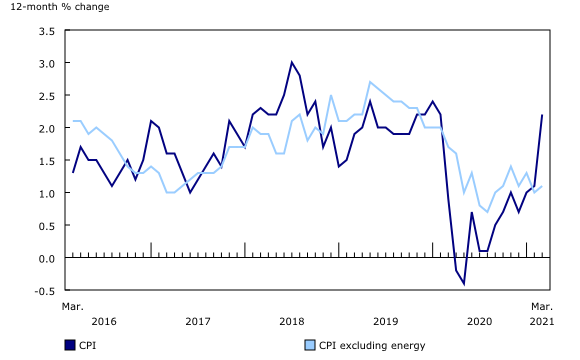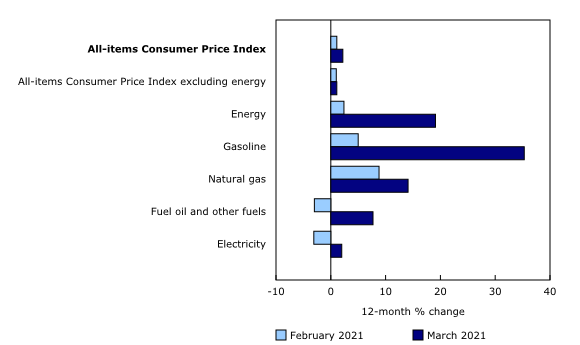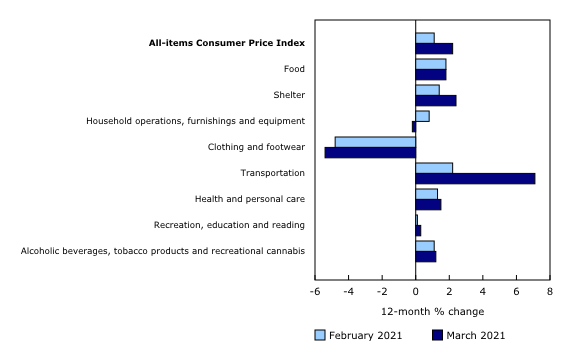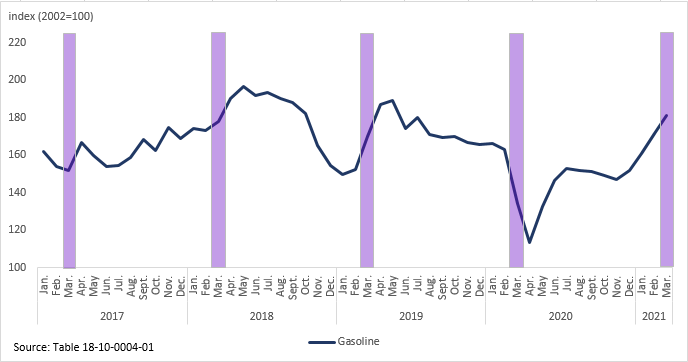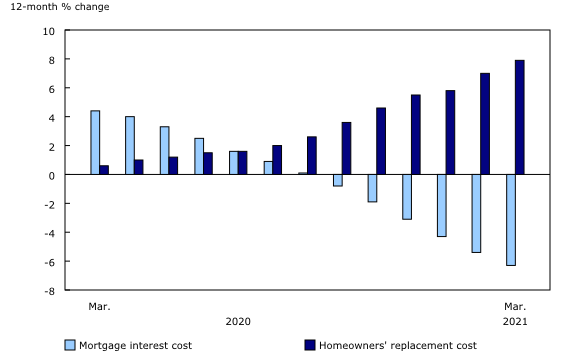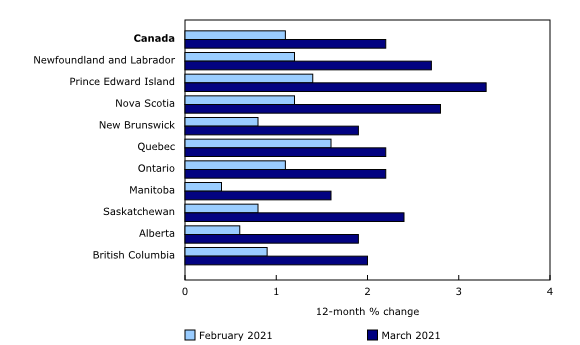Consumer Price Index, March 2021
Archived Content
Information identified as archived is provided for reference, research or recordkeeping purposes. It is not subject to the Government of Canada Web Standards and has not been altered or updated since it was archived. Please "contact us" to request a format other than those available.
Released: 2021-04-21
March 2021
2.2% 
(12-month change)
The Consumer Price Index (CPI) rose 2.2% on a year-over-year basis in March, up from a 1.1% gain in February. A significant proportion of this increase was attributable to a steep decline in prices in March 2020, as the monthly CPI rose 0.5% in March 2021. On a seasonally adjusted monthly basis, the CPI increased 0.1% in March. Excluding energy, the CPI rose 1.1% on a year-over-year basis.
As Canada marked the end of the first year of the COVID-19 pandemic, price growth in March 2021 was accentuated by what is known as base-year effects, originating in March 2020. The broad decline in prices in spring 2020, when headline CPI growth slowed to 0.9% in March 2020, had an upward impact on consumer inflation in March 2021. As the upward impact of these temporary base-year effects will influence the 12-month movement over the next few months, the historical movements affecting current growth trends will be examined.
Base-year effects and the CPI: The COVID-19 experience
The Consumer Price Index (CPI) is a standard measure of the price of a representative basket of goods and services. The headline consumer inflation is measured as the percentage change between the CPI in the current month (March 2021) and the CPI in a base month or the same calendar month of the previous year (March 2020).
A base-year effect refers to the impact that price movements from 12 months earlier have on the current month's headline consumer inflation. When a large downward price change in the base month stops influencing—or falls out of—the 12-month price movement, this has an upward effect on the headline CPI in the current month. Conversely, a large upward price change in the base month creates downward pressure on the current month's measure.
In spring 2020, the global economy was dramatically affected by the COVID-19 pandemic, and Canadian consumers experienced a significant decline in prices from February to April 2020. Headline consumer inflation slowed from +2.2% in February 2020 to +0.9% in March and -0.2% in April, the largest two-month slowdown in year-over-year CPI growth since 1992. The broad decline in prices at the onset of the pandemic, led by prices for energy products and travel services, had an upward impact on the year-over-year rate of consumer inflation in March 2021 because significantly lower prices from March 2020 were used as the basis for year-over-year comparisons.
For instance, gasoline prices were 35.3% higher in March 2021 compared with March 2020, when prices reached a four-year low in the early weeks of the pandemic.
The upward impact of these base-year effects will be temporary. In the coming months, the price declines observed in March and April 2020 will fall out of the 12-month price movement. Users should consider the impact of base-year effects when interpreting the 12-month price movement in the coming months.
Highlights
Year over year, consumer price growth increased within a context of rising consumer confidence and improving employment conditions as COVID-19 restrictions eased in many regions of the country.
In March, prices rose in five of the eight major components year over year, with transportation (+7.1%) and shelter (+2.4%) prices contributing the most to CPI growth. Compared with March 2020, consumers paid less for clothing and footwear (-5.4%) and for household operations, furnishings and equipment (-0.2%).
Energy prices rise on higher demand and lower supply
Gasoline prices led the increase in consumer energy prices, rising 35.3% year over year in March, the largest gain in gasoline prices since March 2000. The price increase was mainly driven by growing global oil demand, as well as the continuation of production cuts by the Organization of the Petroleum Exporting Countries Plus.
Lower prices for gasoline in March 2020 also contributed to the year-over-year increase in March 2021 as a result of the base-year effect. Crude oil prices fell significantly at this time in the previous year as demand for oil dropped because of COVID-19 lockdown measures, leaving an oversupply in the market. As this historical year-over-year decrease ceased to impact the 12-month movement, an additional temporary upward effect influenced the pace of the year-over-year increase in the gasoline index this March.
Similarly, prices for natural gas (+14.1%) and fuel oil and other fuels (+7.7%) increased year over year in March.
Homeowners' replacement costs push shelter prices higher
Shelter prices rose 2.4% on a year-over-year basis in March. As costs for building materials and demand for single-family homes continued to grow, the homeowners' replacement cost index, linked to new home prices, increased 7.9% year over year. The rise in the homeowners' replacement cost index, which comprises about 5% of the CPI basket weight, was partially offset by a drop in the mortgage interest cost index.
The mortgage interest cost index, which makes up about 4% of the CPI basket weight, fell 6.3% year over year.
Consumers pay more for eggs and dairy products in March
Year-over-year growth in the food purchased from stores index remained steady at 1.3% in March, the same increase reported in February. Consumers paid 11.4% more for eggs year over year and 2.4% more for dairy products. Although these products contributed the most to the increase in prices of food purchased from stores, the increase was mainly attributable to lower prices in March 2020. During the early days of the pandemic, demand for eggs plummeted, with the closure of restaurants and other food services causing a surplus in the market.
By contrast, prices for fresh or frozen beef fell 2.1% year over year in March, following a 0.3% gain in February, because of increased supply.
Regional highlights
Year over year, prices rose at a faster pace in March than in February in every province, primarily because of higher gasoline prices.
Energy prices rise in Alberta and Ontario
In Alberta, prices for natural gas were up 35.6% compared with March 2020, when prices declined because of lower demand during the early stages of the pandemic.
Electricity prices in Ontario were up 4.9% on a year-over-year basis. On January 1, 2021, following a province-wide lockdown to reduce COVID-19 infections, the provincial government set all time-of-use electricity prices to the off-peak rate. This fixed pricing ended on February 22, 2021, resulting in higher prices for on-peak and mid-peak electricity consumption.
Rent prices increase in Atlantic Canada
Rent prices rose in all four Atlantic provinces year over year in March: New Brunswick (+4.8%), Prince Edward Island (+2.9%), Newfoundland and Labrador (+2.2%), and Nova Scotia (+2.0%). Higher demand as a result of increased migration and fewer homes for sale contributed to the increase.
Note to readers
COVID-19 and the Consumer Price Index
Statistics Canada continues to monitor the impacts of the novel coronavirus (also known as COVID-19) on Canada's Consumer Price Index (CPI).
Goods and services in the CPI that were not available to consumers in March because of COVID-19 restrictions received special treatments, effectively removing their impact on the monthly CPI. The following sub-indexes were imputed from the monthly change in the all-items index: travel tours, components of spectator entertainment, recreational services, personal care services in some areas, and some components of use of recreational facilities and services in some areas.
The price indexes for beer served in licensed establishments, wine served in licensed establishments and liquor served in licensed establishments were imputed in several regions, using the indexes to which consumers likely redirected their expenditures: beer purchased from stores, wine purchased from stores and liquor purchased from stores.
Consistent with previous months affected by the COVID-19 pandemic, prices for suspended flights are excluded from the March CPI calculation because passengers were ultimately unable to consume them. As a result, selected sub-components of the air transportation index were imputed from the parent index (air transportation).
Detailed documentation is available in the "Technical Supplement for the March 2021 Consumer Price Index," within the Prices Analytical Series (62F0014M). It provides further details on the imputations used to compile the March 2021 CPI.
Explore the Consumer Price Index
Check out the Personal Inflation Calculator! This interactive calculator allows you to enter dollar amounts in the common expense categories to produce a personalized inflation rate, which you can compare with the official measure of inflation that represents the average Canadian household—the Consumer Price Index (CPI).
Visit the Consumer Price Index portal to find all CPI data, publications, interactive tools, and announcements highlighting new products and upcoming changes to the CPI in one convenient location.
Check out the Consumer Price Index Data Visualization Tool to access current and historical CPI data in a customizable visual format.
Real-time data tables
Real-time data table (18-10-0259-01) will be updated on May 3, 2021. For more information, consult the document "Real-time CANSIM tables."
Next release
The Consumer Price Index for April will be released on May 19, 2021.
Products
The "Consumer Price Index Data Visualization Tool" is available on the Statistics Canada website.
More information on the concepts and use of the Consumer Price Index (CPI) is available in The Canadian Consumer Price Index Reference Paper (62-553-X).
For information on the history of the CPI in Canada, consult the publication Exploring the First Century of Canada's Consumer Price Index (62-604-X).
Two videos, "An Overview of Canada's Consumer Price Index (CPI)" and "The Consumer Price Index and Your Experience of Price Change," are available on Statistics Canada's YouTube channel.
Contact information
For more information, or to enquire about the concepts, methods or data quality of this release, contact us (toll-free 1-800-263-1136; 514-283-8300; STATCAN.infostats-infostats.STATCAN@canada.ca) or Media Relations (613-951-4636; STATCAN.mediahotline-ligneinfomedias.STATCAN@canada.ca).
- Date modified:


